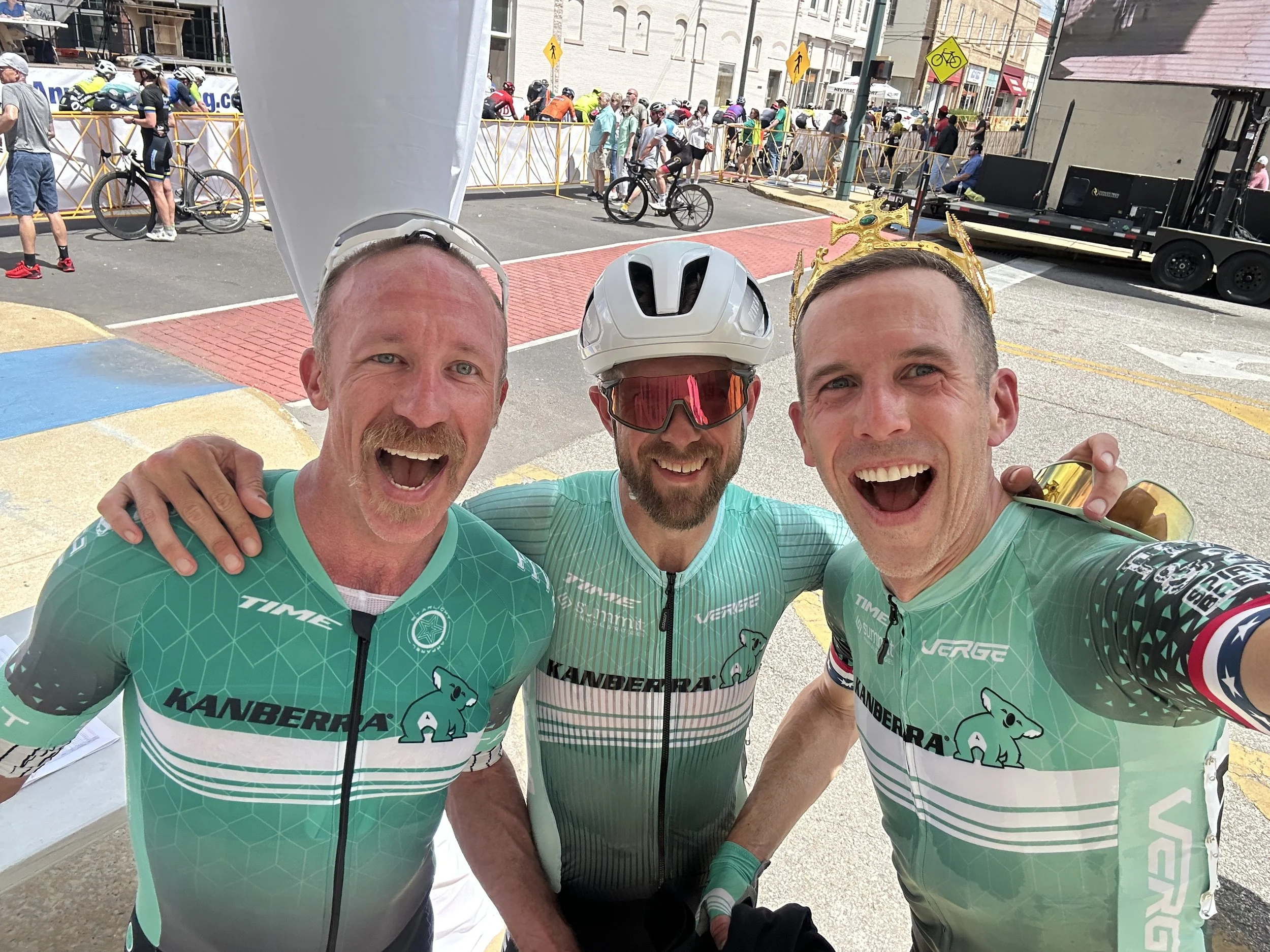Train Smarter: 2 Rides That Make You Faster
TLDR: The goal of this post is: Can we QUICKLY provide you with a clear purpose for every ride and the right mix of endurance, high intensity, and recovery.
I’ve been scouring through some old EVOQ posts…some of these are from 2019! This was a great Velonews Podcast, #68. In the podcast, they discuss Long Slow Duration Rides, High Intensity, and Recovery Rides.
If you want to get faster on the bike, and you’re short on time and true bandwidth to really coach yourself, we need to make this SIMPLE…we can’t be wasting time figuring out the training each day.
In this post, I’m breaking down key takeaways from a Velonews podcast and our own coaching experience, so you can train smarter, avoid burnout, and see real performance gains.
Common Training Pitfalls
Before we talk about the three ride types, let’s cover a few mistakes that hold cyclists back:
1. Overcomplicating Intervals
Many cyclists pile too much into a single ride—switching intensities, chasing random power numbers, or doing “kitchen sink” sessions. Unless you’re a Cat 1–2 simulating a race, keep most workouts focused on training one specific system.
Related Post: Complete Guide to Cycling Interval Training
2. Thinking “If It Doesn’t Hurt, It Doesn’t Work”
Hard rides aren’t the only rides that make you faster. Long endurance rides below threshold can leave you physically tired without frying your nervous system—these are the rides that quietly build huge aerobic engines.
Many cyclists never complete a long endurance ride that empties that tank, but not in a thrashed way that a race does. You get tired but you never go over tempo, or 90% of your FTP. This ride builds massive endurance engines, for an endurance spot, and will make you a faster cyclist
3. Losing Sight of the Big Picture
There are many times during a season where you will hit a workout that you REALLY struggle with, or cannot complete. As competitive people and cyclists, this feels like a failure to so many athletes.
If you aren’t failing, you aren’t trying hard enough. That holds true in and outside of the sport.
Think of uncovering an area where you fail at as a highly targeted area where you can now improve yourself! Maybe it’s time to work on this limiter!
One bad workout doesn’t define your season. A coach helps you step back and see the forest, not just the trees—keeping training purposeful and event-focused.
4. Too Much High Intensity
Many riders ride hard too often. Group rides feel satisfying, but they often don’t stress the right systems enough to improve performance. The result? Chronic fatigue without progress.
You need a solid base of endurance miles, a really strong body from lifting weights, and then intensity dosed at the right time for the right events.
People ride too hard, too often, which gets in the way of their growth as a cyclist, and stunts their performance.
The 2 Ride Types You Need To Get Faster
1. Long Endurance Ride (LSD – Long Slow Distance)
Purpose: Build your aerobic base and fatigue resistance.
Effort: Aerobic threshold (around 60–75% of FTP, meaning your average watts for the ride will end up around 60-65%. Try to put a cap on the watts around 80% FTP.
Duration: 3–5+ hours depending on training experience. Work up to more long rides, and longer long rides, as you progress.
Execution: Stay in Zone 1-3, pedal consistently (minimal Zone 1 coasting), and keep stops short. I know, a cafe ride is a thing, but it’s not great endurance training.
Why It Works: Long rides train slow-twitch fibers, improve fat utilization, and even recruit fast-twitch fibers aerobically when fatigue sets in.
2. High-Intensity Intervals
Purpose: Develop Maximal Aerobic Power, Sharpen top-end power, prepare for race efforts.
Effort: Above FTP, often VO₂max or anaerobic zones.
Execution: Fewer, harder intervals are better than many mediocre ones. Aim for quality over quantity—stop the set if power drops significantly.
Why It Works: Short blocks of high intensity raise your performance ceiling quickly, especially when layered on top of a strong aerobic base. This is why base season is longer than your first race build!
Related Post: Cycling Training Zones: Which Ones Should You Use?
Cardiac Drift & Muscle fibers
It’s worth bringing this up from the podcast. This is really interesting. They mention a 5h ride at 180W and start at 130bpm but at the end you will be 145bpm; dehydration and muscle fiber fatigue. As your muscles fibers get damaged and call out to more and more fibers, the fast twitch muscle fibers have to work aerobically which is a massive gain. You can train fast twitch without the autonomic stress and make gains that don’t involve massive fatigue.
Don’t stop at the coffee shop; it’s too much rest. We Agree!
Yes, there is a point to these long rides and being able to utilize fat at the highest rate possible but at the end of the day, we’re all doing carb dependent racing. Not fat dependent.
Going to exhaustion at submaximal pace, or aerobic and endurance pace, you’re tapping into ALL your muscle fibers without going into maximum intensity. Use everything that you’ve got and that will be a hard ask for muscles that aren’t used to doing them.
Finish The Intervals?
They talk about intervals and when to complete them and when to turn around and go home. This has been talked about for a while. In the popular book, Training and Racing With A Power Meter, they give claim to specific percentage decreases in power which determined if you should keep training, or just head home.
In this long thread in the WKO4 Power Users group on Facebook, Tim Cusick discusses this at one point in this post:
https://www.facebook.com/groups/WKO4powerusers/permalink/2042098752781948/
End of the day, your hard intervals need to be really hard. If you are prescribed 5 of them, they need to be REALLY HARD. It would be better to do 2 at supreme max intensity, than hold back so that you can complete 4 of them at 97%.
Now I find the interesting that Trevor Connor agrees with this because Dr. Seiler talks about never going over 90% or the lactate build up interferes with adaptations. This is another issue with the 3 zone model in my opinion, as you are never going FULL GAS and just expected to turn that on come race day? That does NOT work for most amateurs racers!
The podcast mentions the ability to get sharp in 3-6 weeks…depends what sharp is. If you are not an anaerobic athlete, and really looking to change this for whatever reason, in order to perform better in some specific races, it might take much longer than 3 weeks time! Be aware of that.
How much high intensity to you really need? Even though there is a long season ahead, it would be wise to stay on the gas from time to time (one per week, or once per ten days) to limit major losses in VO2max and blood plasma volume, etc.
Final Coaching Thoughts
1) ARE YOU GETTING FASTER? IF THINGS AREN’T WORKING, CHANGE THEM UP. We tell all our athletes that when we start working with them, it’s like a first haircut. You get in and we might not get the sideburns JUST right, but we can tweak that. The same for training; some things just don’t work for certain athletes, and you need to test them and then change it up.
2) To develop the endurance engine, it takes years and years and years. To build the high end throttle, it takes weeks to months. It’s the two together that make the total athlete, and so many athletes have lost this concept.
3) Training does damage, recovering repairs that damage; that is where compensation takes place.
4) Every ride should have a purpose, so go after that purpose and hold yourself to it.
5) Joe Friel: the event is the reason we train; we don’t train just for numbers! We train for outcomes in races. Sometimes you’re 80% easy / 20% intense, sometimes 70/30, or other times 90/10. It all depends on what you are training for! Do you need long intervals that will take up more of your training time (70/30), or are you honing in on a 90 second finish uphill that will be a small amount of time, but at extremely high intensity (90/10)?
Again, the training is event specific and dealing with your weaknesses. If you already are the best at 90 second efforts, you might be working on your aerobic system more to make sure you are there at the end, to WIN that 90 second effort!
Back to reality: Here’s the deal, you need a little bit of everything and make it race specific.
6) Finally, take chances and learn about yourself as a cyclist.
Blow Yourself Up in training races and “real races”; don’t be embarrassed about it. Is your ego too big to learn more about yourself and see yourself halfway down on the results sheet? That will make you faster, and stronger, down the road. Trust us!
Race smart on the weekends and race hard on the weekdays. Go to the training race to kill yourself. Experiment and try new things.
Keep it simple.
Keep it purposeful.
How does it all fit together?
Thanks for reading, and contact us today to learn how you can get faster!


